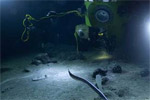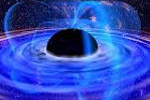Biology |
|
Biologija |
Deepest point in the ocean is teeming with life

|
|
Najdublja točka u oceanu vrvi životom

|
Science |
|
Znanost |
US research to be put online for free

|
|
Američka će istraživanja biti besplatno stavljena na internet

|
Society |
|
Društvo |
Our evolved morality has failed us

|
|
Naš nas je evoluirani moral izdao

|
Ecology |
|
Ekologija |
US gets tough on Arctic oil drilling

|
|
SAD postaju strože u vezi bušenja nafte na Arktiku

|
Technology |
|
Tehnologija |
Smelling screen that lets you really smell the coffee

|
|
Mirisni zaslon koji vam omogućuje da stvarno osjetite miris kave

|
Astronomy |
|
Astronomija |
The fastest trip yet to the International Space Station

|
|
Najbrže putovanje dosad na Međunarodnu svemirsku postaju

|
A new toy solves cosmic puzzles

|
|
Nova igračka rješava kozmičke zagonetke

|
Cuisine |
|
Kulinarstvo |
Roasted asparagus with Parmesan cheese

|
|
Pečene šparoge s parmezanom

|
|
|
|
|

Deepest point in the ocean is teeming with life
Hollywood director James Cameron found little evidence of life when he descended nearly 11,000 metres to the deepest point in the world's oceans last year.
If only he had taken a microscope and looked just a few centimetres deeper.
Ronnie Glud at the University of Southern Denmark in Odense, and his colleagues, have discovered unusually high levels of microbial activity in the sediments at the site of Cameron's dive - "Challenger Deep" at the bottom of the western Pacific's Mariana Trench.
Glud's team dispatched autonomous sensors and sample collectors into the trench to measure microbial activity in the top 20 centimetres of sediment on the sea bed.
The pressure there is almost 1100 times greater than at the surface.
Finding food, however, is an even greater challenge...
 Search for more... Search for more... 
Hollywood director James Cameron found little evidence of life when he descended nearly 11,000 metres to the deepest point in the world's oceans last year.
If only he had taken a microscope and looked just a few centimetres deeper.
Ronnie Glud at the University of Southern Denmark in Odense, and his colleagues, have discovered unusually high levels of microbial activity in the sediments at the site of Cameron's dive - "Challenger Deep" at the bottom of the western Pacific's Mariana Trench.
Glud's team dispatched autonomous sensors and sample collectors into the trench to measure microbial activity in the top 20 centimetres of sediment on the sea bed.
The pressure there is almost 1100 times greater than at the surface.
Finding food, however, is an even greater challenge.
Any nourishment must come in the form of detritus falling from the surface ocean, most of which is consumed by other organisms on the way down.
Only 1 per cent of the organic matter generated at the surface reaches the depth of 6,000 metres.
What are the chances of organic matter making it even deeper, into the trenches that form when one tectonic plate moves beneath another?
Surprisingly, the odds seem high.
Ocean trenches are particularly good at capturing sediment.
They are broad as well as deep, with a steep slope to the deepest point, so any sediment falling on their edges quickly gets down to the bottom in muddy avalanches.
Although the sediment contains no more than 1 per cent organic matter, so much sediment ends up at the bottom that the level of microbial activity is incredible.
With the exception of temperatures much above boiling, bacteria seem to cope with almost anything.
» Search for more... 
|
|

Najdublja točka u oceanu vrvi životom
Hollywoodski je redatelj James Cameron pronašao malo dokaza o životu kada se prošle godine spustio gotovo 11.000 metara na najdublju točku u svjetskim oceanima.
Da je barem uzeo mikroskop i pogledao samo nekoliko centimetara dublje.
Ronnie Glud sa Sveučilišta južne Danske u Odenseu i njegovi kolege otkrili su neuobičajeno visoke razine mikrobiološke aktivnosti u sedimentima na lokaciji Cameronovog zarona - "Dubini Challenger" na dnu Marijanske brazde u zapadnom Tihom oceanu.
Gludov je tim poslao autonomne senzore i skupljače uzoraka u brazdu kako bi izmjerio mikrobiološku aktivnost u gornjih 20 centimetara taloga na morskom dnu.
Pritisak je tamo gotovo 1100 puta veći nego na površini.
Međutim, pronalaženje hrane je još veći izazov od preživljavanja visokih pritisaka...
 Potraži više... Potraži više... 
Hollywoodski je redatelj James Cameron pronašao malo dokaza o životu kada se prošle godine spustio gotovo 11.000 metara na najdublju točku u svjetskim oceanima.
Da je barem uzeo mikroskop i pogledao samo nekoliko centimetara dublje.
Ronnie Glud sa Sveučilišta južne Danske u Odenseu i njegovi kolege otkrili su neuobičajeno visoke razine mikrobiološke aktivnosti u sedimentima na lokaciji Cameronovog zarona - "Dubini Challenger" na dnu Marijanske brazde u zapadnom Tihom oceanu.
Gludov je tim poslao autonomne senzore i skupljače uzoraka u brazdu kako bi izmjerio mikrobiološku aktivnost u gornjih 20 centimetara taloga na morskom dnu.
Pritisak je tamo gotovo 1100 puta veći nego na površini.
Međutim, pronalaženje hrane je još veći izazov od preživljavanja visokih pritisaka.
Svaka hrana mora stići u obliku organskih otpadaka koji padaju s površine oceana, od kojih većinu na putu prema dolje konzumiraju drugi organizmi.
Samo 1 posto organske tvari koja nastane na površini stigne do dubine od 6.000 metara.
Kakve su šanse da organska materija dospije još i dublje, u brazde koje nastaju kada se jedna tektonska ploča pomakne ispod druge?
Začudo, izgledi se čine visokima.
Oceanske brazde su posebno dobre u hvatanju taloga.
One su i široke i duboke, uz strmi nagib prema najdubljoj točki, pa svaki talog koji padne na njihove rubove brzo dospije na dno u blatnim lavinama.
Iako talog sadrži ne više od 1 posto organske tvari, tolika količina taloga završi na dnu da je razina mikrobiološke aktivnosti nevjerojatna.
S izuzetkom temperatura koje su znatno iznad vrelišta, čini se da se bakterije mogu nositi s gotovo bilo čime.
» Potraži više... 
|
|
|
|
|

Our evolved morality has failed us
Rob a bank and you risk a long stretch in jail.
Run a bank whose dubious behaviour leads to global economic collapse and you risk nothing of the sort, more likely a handsome pay-off.
Illegal and dangerous mistakes associated with the financial industry have caused serious harm to US and world economies.
That is beyond doubt.
And the scandals keep coming.
The wider backlash against the industry shows no sign of easing.
So given the scale of damage and public anger, fuelled by the industry's bonus culture, it is curious that those responsible have largely avoided punishment in the traditional judicial sense, despite the clamour for it.
That we so want bankers to get their just deserts has its roots in ancient human forms of social control, which led to our modern sense of morality.
What happens when lawbreaking becomes embedded in large, hard-to-understand economic systems, and when the immediate damaging consequences seem to be diffuse and institutional, rather than direct and personal?..
 Search for more... Search for more... 
|
|

Naš nas je evoluirani moral izdao
Opljačkajte banku i time riskirate dug boravak u zatvoru.
Vodite banku čije upitno ponašanje vodi do globalnog ekonomskog sloma i time ne riskirate ništa slično, vjerojatnije je da će vam se dobro isplatiti.
Nezakonite i opasne pogreške povezane s financijskom industrijom nanijele su ozbiljnu štetu američkom i svjetskom gospodarstvu.
To je izvan svake sumnje.
A skandali i dalje stižu.
Šira reakcija protiv te industrije ne pokazuje znakove slabljenja.
Dakle, s obzirom na razmjere štete i javne ljutnje, a koju dodatno potiče kultura isplaćivanja bonusa u toj industriji, zanimljivo je da su odgovorne osobe uvelike izbjegle kaznu u tradicionalnom pravosudnom smislu, unatoč buci koja se podigla oko toga.
To što mi toliko želimo da bankari dobiju ono što su zaslužili ima korijene u drevnim ljudskim oblicima društvene kontrole, koji su doveli do našeg modernog osjećaja za moral.
Što se događa kada kršenje zakona postane ugrađeno u velike, teško razumljive gospodarske sustave i kada se neposredne štetne posljedice čine difuznima i institucionalnima umjesto izravnima i osobnima?..
 Potraži više... Potraži više... 
|
|
|
|
|

The fastest trip yet to the International Space Station
Now it is possible to get to the International Space Station (ISS) in less time than it takes to fly from London to New York.
A Russian Soyuz capsule usually takes at least two days to get to the ISS, because of the carefully timed manoeuvres that are required for this.
Using a new launch process, three astronauts have now made the trip in just under 6 hours.
Russian cosmonauts Pavel Vinogradov and Alexander Misurkin and NASA astronaut Chris Cassidy started the trip at 20:43 on 28 March from the Baikonur Cosmodrome in Kazakhstan.
They successfully docked with the space station at 02:28, just 5 hours and 45 minutes later.
The Soyuz itself wasn't flying any quicker than normal.
The mission managers simply had to be more precise this time.
When a Soyuz capsule enters orbit, it is on an orbital path a bit lower than the space station's, which means it circles the Earth faster.
As the craft closes in on the ISS, a series of thruster burns boosts the capsule into the right orbit for docking.
Getting Soyuz to match the station's altitude and speed is a tricky business...
 Search for more... Search for more... 
|
|

Najbrže putovanje dosad na Međunarodnu svemirsku postaju
Sada je moguće doći do Međunarodne svemirske postaje (ISS - International Space Station) za manje vremena nego što je potrebno za let od Londona do New Yorka.
Ruskoj kapsuli Soyuz obično su potrebna najmanje dva dana kako bi stigla do ISS-a, zbog pomno tempiranih manevara koji su za to potrebni.
Korištenjem novog procesa lansiranja, tri su astronauta sada završila putovanje za nešto manje od 6 sati.
Ruski astronauti Pavel Vinogradov i Alexander Misurkin i NASA-in astronaut Chris Cassidy započeli su putovanje u 20:43 sati na dan 28. ožujka iz kozmodroma Baikonur u Kazahstanu.
Uspješno su se spojili sa svemirskom postajom u 02:28 sati, samo 5 sati i 45 minuta kasnije.
Sam Soyuz nije letio brže nego što je uobičajeno.
Voditelji misije jednostavno su ovaj put morali biti precizniji.
Kada kapsula Soyuz uđe u orbitu ona se nalazi na nešto nižoj putanji od putanje svemirske postaje, što znači da brže kruži oko Zemlje.
Dok se letjelica približava ISS-u, niz aktivacija potisnika podiže kapsulu u pravu orbitu za pristajanje.
Problematično je dovesti Soyuz na identičnu visinu i brzinu kakvu ima i postaja...
 Potraži više... Potraži više... 
|

A new toy solves cosmic puzzles
A black hole is defined by its gravity.
But now a new model that ignores gravity is proving surprisingly useful for understanding how these cosmic giants work.
Black holes are where big ideas in cosmology, such as gravity and quantum mechanics, collide.
That makes them great for testing new theories.
"A black hole is a bit like the hydrogen atom of quantum gravity", says Samuel Braunstein of the University of York, UK.
"It's a place to test ideas and test theories, to see what may or may not happen".
His team modelled a minimal black hole, defined only by having an inside and an outside, using quantum theory...
 Search for more... Search for more... 
|
|

Nova igračka rješava kozmičke zagonetke
Crna rupa je definirana svojom gravitacijom.
Ali sada se novi model koji ignorira gravitaciju dokazuje iznenađujuće korisnim za razumijevanje kako ovi kozmički divovi funkcioniraju.
Crne rupe su mjesta gdje se sudaraju velike ideje u kozmologiji, poput gravitacije i kvantne mehanike.
To ih čini odličnima za testiranje novih teorija.
"Crna rupa je nešto poput vodikovog atoma kvantne gravitacije", kaže Samuel Braunstein sa Sveučilišta u Yorku u Ujedinjenom Kraljevstvu.
"To je mjesto za testiranje ideja i testiranje teorija, kako bismo vidjeli što bi se moglo ili ne bi moglo dogoditi".
Njegov je tim izradio model minimalne crne rupe koja je određena samo time što ima unutrašnji i vanjski dio, koristeći kvantnu teoriju...
 Potraži više... Potraži više... 
|
|
|
